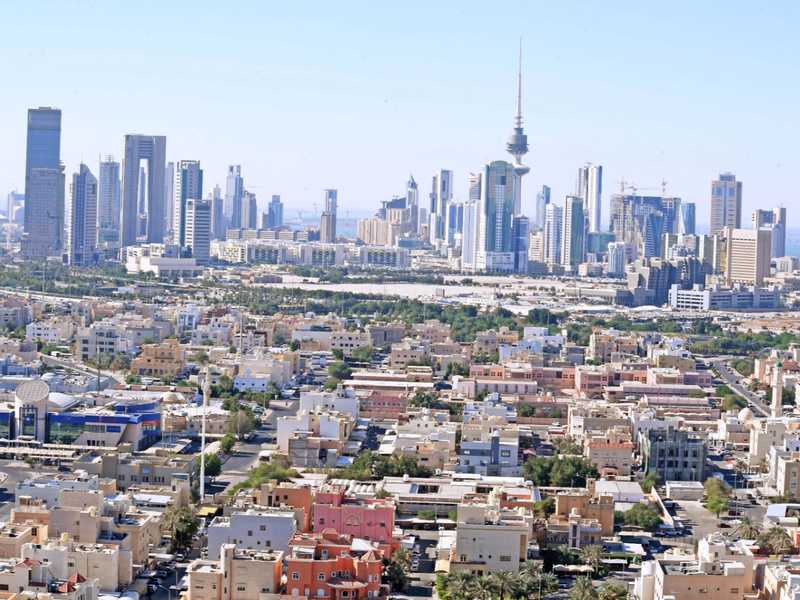Source:-.arabtimes
KUWAIT CITY, April 17: The local real estate sector is an essential pillar of investment for companies and individuals, and a safe haven for those wishing to preserve the value of their money and savings. However, in light of the global economic turbulence, real estate agents are currently interested in following up their investment conditions. Usually when entering a stage of recession, as the market is currently in, the investor searches through his files and re-reads his investment map, reports Al-Qabas daily.
n a recent study by the daily, Aayan Real Estate Company shed light on the prospects of the local real estate sector to diagnose the current market situation and anticipate future expectations by providing insights and valuable information to investors and providing them with the latest information and data that contribute to supporting their investment decisions.
According to the study, the total number of private housing plots in Kuwait is about 207.1 thousand plots of land in 90 different areas as of the end of 2022, with the exception of the Sabah Al-Ahmad Marine City.
Mutlaa is considered the largest residential city in the country, as it includes about 28.2 thousand plots of land.
The total area of all land used in 2022 for private housing in Kuwait is 99.45 million square meters, with an average area of 480 square meters for each land. It is expected to exceed 100 million square meters in 2023, as there are many cities under planning by the Public Authority for Housing Welfare (PAHW).
The number of vacant private housing land in 2022 was about 41.60 thousand plots, equivalent to 20 percent of the total number of land in general (including the city of Mutlaa). This is a very low percentage compared to any Gulf country, as the percentage of vacant residential lands is between 35 percent and 40 percent in different countries of the Gulf Cooperation Council.
The average rate of rentals for the investment sector is expected to decrease in 2023 by 8.5 percent compared to 2019 to reach about KD 4.420 per square meter. The occupancy rate is likely to increase slightly to 85.5 percent in 2023 from 85.1 percent in 2022 to reach 86 percent in 2024 and then to 87 percent in 2025.
There are 2,205 vacant investment residential lands in Kuwait, which is equivalent to 14.7 percent of the total residential investment properties. This is a very low rate compared to the neighboring regional markets, where the percentage exceeds 40 percent. This therefore will impose restrictions on supply, which in turn will lead to an increase in occupancy and prices within the sector.
The value of rents in the commercial sector may decrease by about five percent annually until 2024. The sector in general witnessed a correction of 10-15 percent in rental rates during the past 18 months.
Commercial complexes represent 16 percent of the leasable area at 909.9 thousand square meters at the level of the commercial sector. Shopping centers accounted for 6 percent by about 328.5 thousand square meters. Other leasable properties represent 74 percent at about 4.11 million square meters in different areas of Kuwait.
The total area of the offices used by the public and private sectors amounted to about 7.24 million square meters in 2022. The government’s share of the demand for office space was 47 percent, and the private sector 53 percent at 3.84 million square meters. It is expected to witness an increase to 4.12 million square meters by 2025.
The private sector owns about 282 properties allocated for office spaces in Kuwait City. Among these properties, about 250 properties are available for rent. As for the remaining properties, they are used by their owners.
The office space under construction in the country is estimated at 265 thousand square meters, distributed between 183.02 thousand square meters in Kuwait City, and about 82.74 thousand square meters outside the city.
The Capital Governorate accounts for 70 percent of those spaces for available commercial real estate, and Kuwait City real estate generates annual rental income of USD 314 million.
Regarding the office rental rates, the study estimated the rental prices for offices of various levels and sizes as follows:
- Luxurious and distinguished offices – ranges from KD 6 to KD 14 per square meter, depending on the location and unit sizes.
- Mid-level offices – ranges from KD 5.5 to KD 12.7 per square meter.
The study by Aayan Real Estate Company revealed a discussion currently taking place about plans by several government agencies to acquire land in Kuwait City to establish their own buildings. If this is actually done, it may have dangerous repercussions on the performance of the office sector.
From the point of view of the study, occupancy rates will be directly affected according to the likely scenario. In the event that the privately owned offices occupied by the government are vacated during the next three years, the occupancy rate will drop to 74 percent instead of 81.1 percent. This may lead to a decline in the values of many assets, failure to repay loans to banks, and loss of hundreds of jobs in the private sector.
According to the study, the government sector occupies 237,482 square meters of office space in different areas with a rental rate of approximately KD 8 per square meter, which means it spends about KD 22.8 million for annual rents.
Assuming that the official authorities decide to withdraw from the office market and construct their own real estate, it will need an area estimated at 45,670 square meters, if the average construction rate in Kuwait City is 520 percent.
The average price of land in the Capital Governorate is KD 8,500 per square meter, and thus the total value of the expected required area is about KD 388.2 million.
In order to develop an area of 237,482 square meters, the state will work to build twice that area for corridors and public services. Therefore, the total construction cost will amount to about KD 166.2 million. This means that the total spending on land and construction will amount to about KD 554 million (USD 1.8 billion). Thus, the government will save what it spends on renting offices by KD 22.8 million annually.
In theory, this means that it will take 24.3 years for it to start saving rent from its existing office space







